Review for Okami-san and Her Seven Companions: Complete Series Collection
Introduction
Before, it simply used to be word of mouth and illicit fansub that told us of the next big thing in anime. It would only be the occasional title though that would get noticed enough to get fans buzzing, and pre-emptively demanding distributors to get it licensed. Now that so many of our first encounters with anime come courtesy of simulcasts and online streaming, it’s becoming a rare thing indeed to be surprised by a title. Ninety percent of what comes out in Japan is streamed somewhere in the West, and it isn’t long before positive or negative opinion of that begins to spread. I haven’t gone completely cold into a show in quite a long while now. Yet when Okami-san and Her Seven Companions turned up for review, for the first time in years, I found I knew absolutely nothing about an anime. To be fair, I had heard of it, but the only impact it had on my awareness was my categorising it as ‘not Spice and Wolf’ (Okami means wolf). For the first time in ages, I’m going into a show completely unaware of what to expect.
It isn’t long before I realise that fairy tales play a big part in Okami-san and Her Seven Companions. In Otogibana City, at the Otogi Academy High School, there exists the Otogi Academy Mutual Student Aid Association, a.k.a. the Otogi Bank. Its group of students work together to provide favours, offer assistance to other students in need, although the condition is that the debt has to be repaid in kind. The story begins with Ryoshi Morino, on the surface a weak and spineless boy who has a phobia about being looked at. Somehow he’s developed a crush on the toughest, strongest member of the Otogi Bank, Ryoko Okami, a girl who likes rough-housing so much that she has a pair of specially designed kitty boxing gloves.
It isn’t long before Ryoshi is recruited as the newest member of the Otogi Bank, and he has a chance to prove to Ryoko that he does indeed have some mettle. But Ryoko’s isn’t the only gaze that Ryoshi would prefer to avoid, as the other members of the Otogi Bank are unique personalities in their own right. Ryoko’s roommate Akai Ringo insists on matchmaking between the pair. The president of the bank is the multi-talented Liszt Kiriki, while his deputy is also his forbidding cousin Alice. Urashima is a complete womaniser, while Otohime owns Urashima; I mean she’s his girlfriend. Otsu is the maid, every bank needs a maid, and it turns out that every bank also needs a mad scientist, in this case Majo. The members of the Otogi Bank get up to all sorts of adventures as they offer their services to the student body.
Twelve episodes of Okami-san and Her Seven Companions are presented across two discs by Manga Entertainment.
Disc 1
1. Okami-san and her Otogi Bank Companions
2. Okami-san the Liar and Ryoshi-kun
3. Okami-san Gets Caught in the Fight
4. Okami-san and Otsu-senpai’s Favour Repayments
5. Okami-san Goes Oni-Hunting With Momo-chan-senpai
6. Okami-san and the Akazukin-chan and while we’re at it
Disc 2
7. Okami-san Goes on a Double Date with Jizou-san
8. Okami-san and the Mouse Bride Search
9. Okami-san and Snow White, Who is Immune to Poison
10. Okami-san and the Otogi Bank’s Really Long Day
11. Okami-san and the Wolf in Sheep’s Clothing
12. Okami-san and the Girl Who Doesn’t Sell Matches
Picture
Manga Entertainment give Okami-san and Her Seven Companions a 1.78:1 native PAL anamorphic transfer. It’s clear and sharp throughout, with bold colours, and puts across the animation smoothly and without any significant issue, other than some minor compression noise around fast moving sequences. The character designs are fairly generic for anime, but are agreeable enough, and the world design is equally as prosaic. The quality of the animation itself is good, with few instances of static scenes and shortcuts in the animation. The action sequences in particular come across well, especially when Okami dons her kitty boxing gloves and cuts loose on some deserving delinquents.
Sound
Audio comes in DD 5.1 English and DD 2.0 Japanese forms, with optional translated subtitles and a signs only track. I went with the Japanese audio and found it agreeable enough, with somewhat clichéd voices for the somewhat clichéd characters. I gave the dub a spin and found it to be just as predictable in terms of voice casting for character type. It also doesn’t really do all that much with the 5.1 soundstage. The notable thing about Okami-san is the presence of the narrator, who plays a much larger role in the show. Indeed she is liable to talk over the main characters and even drown out their dialogue. It’s an opportunity for wry witty asides and the cracking of the fourth wall, and it is pretty charming, if you can get over the main characters being buried. Personally I couldn’t get used to this aspect of the show, and found it detrimental. It’s down to personal preference of course. Also it seems like the English dub narration is a straight translation of the Japanese, something of a lost opportunity in localisation.
The problem with Manga’s release is in the subtitling. I’ve become used to US anime companies’ subtitling to be of a higher standard, whether it’s using different fonts or different colours, having dialogue translations and text captions on screen simultaneously, placing text captions over the text they are translating rather than with the dialogue captions. When it falls to a company that only rarely authors discs these days, it’s easy to forget that not everyone has the resources to be as proficient. Manga Entertainment’s Okami-san discs can apparently only have a few lines of text on screen at any one time, and then only in one place on screen. For the majority of the episodes this isn’t much of a problem. But episode 3 is an episode with a lot of plot specific on-screen text, and very little of it is translated, either in the subtitles or the signs only track. Viewers will miss out on several punch-lines as a result. The reverse happens in episodes 10 and 12, with text translations apparent, but dialogue translations missed. In this case it’s easy to switch to the dub to get an idea of what was said, but it is still inconvenient.
The third thing is inconsistency in subtitling the narrator. Manga chose italics to signify her comments, but they look like the normal font and they soon forget to use italics for the narrator anyway, switching back and forth. With the narrator’s dialogue mixed up with the character dialogue, it’s hard to tell sometimes which subtitle belongs to which character, and with the narrator drowning out the characters, Manga’s subtitles are inconsistent. Sometimes they translate the drowned out dialogue, sometimes they don’t. At the very least, the narrator’s dialogue should have been subtitled in a different colour, or placed at the top of the screen.
Extras
These discs are authored by Manga Entertainment themselves this time, rather than sourcing Australian discs as usual. This is because of late, Australia’s Madman Entertainment are releasing more and more DVDs in NTSC format which they can more easily do in Region 4. Okami-san was released as NTSC (a simple port of the Funimation Region 1 discs) in Australia. NTSC DVDs in Region 2 are ripe for reverse importation from Japan, while Japanese DVD players won’t play PAL discs, all of which makes releasing NTSC anime DVDs a little more difficult here.
Thankfully, these PAL discs from Manga do have a separate signs only track to go with the English dub, which up till now Manga have left out on their in-house releases, although it does still have a couple of issues in the subtitle department as mentioned. But as usual, Manga Entertainment’s chaptering leaves something to be desired. There’s no skipping the credit sequences here. They’re also a little light in the extras department compared to the US and AU releases, as Manga haven’t sourced the Funimation commentaries that were on episodes 1 & 6.
What we do get are some very nice animated menus that present the episodes. Disc 1 has a couple of promos for the show. The Tokyo International Anime Fair Promo Video lasts 3 minutes, and is a fair introduction to the show. The other Promo Video just lasts 90 seconds, and is pretty much your usual trailer. On disc 2 we get four of the original TV commercials, although the fourth one isn’t subtitled. We also get the textless credits, and the US trailer from Funimation.
Conclusion
When a girl does a full on gymnastic routine, a lengthy run up before launching into a series of flips, tumbles, somersaults and cartwheels, all to kick the boy that she loves in the face, you’d think you were onto something special. Alas, for me that turned out to be the high point of Okami-san and Her Seven Companions, and that happened in the first episode. I found Okami-san to be just another generic romantic comedy, albeit one that dazzles you with a couple of gimmicks, with a central pairing of tsundere female and wimpy male par for the course, with the other characters neatly fitting into the usual character stereotypes. It’s funny at times, entertaining most certainly, but it never does enough to stand out from the crowd, and ultimately it is very forgettable.
The first gimmick is the narrator, an opportunity for comedy gold if used wisely. That isn’t the case here, as she’s really overused, and prone to stating the obvious, and as mentioned, I actually got tired of her overpowering the characters on screen. I was far more interested in what they had to say than what she did. The narrator here works best when the fourth wall collapses and she starts interacting with the characters, and there are a couple of choice glares out of the screen when she happens to say the wrong thing. The second gimmick is the fairy tale tie in, which in this case is underused. We have the wolf in Ryoko Okami living with Red Riding Hood in Ringo, with the hunter Ryoshi falling in love with her. The opening episode offers that somersaulting Cinderella gag which I found hilarious, and through the series, there are a couple of allusions to classic fairy tales, The Little Match Girl, The Three Little Pigs, Snow White and the Seven Siblings and a few others. But none of these is as effectively used as that Cinderella parody.
What does appeal about the show is its set-up, with a high school club that works on the favour principle. They do favours for people who ask for them, and the people then owe the club favours. It’s a form of economics that’s a lot more altruistic than cold hard cash, although the Otogi Bank president Liszt Kiriki treats it the same way. But it does involve the club members being something of odd-job men, called on to do all manner of tasks for whoever’s requests are approved, whether it’s matchmaking for a society heir, or delivering a beatdown to the neighbourhood loan sharks.
The Otogi Bank’s go to girl when it comes to beatdowns is Ryoko Okami, the central tsundere character. She’s a girl who likes to fight, spends her time training in the boxing ring, and delivers her devastating punches with a pair of personalised gloves that meow when they make contact. Except that she has a stalker in Ryoshi, a boy with terminal shyness who can’t bear to be looked at. But he’s seen through the tough exterior to Ryoko’s soft and vulnerable heart, and he wants to be the one to protect her. So it is that he becomes a member of the Otogi Bank, where he too will work doing favours, and hopefully overcome his shyness. That isn’t helped by Ryoko smacking him whenever he gets too goofy, but slowly and over the course of the series, her heart begins to melt as well.
The rest of the Otogi Bank is a varied mix of characters. Ringo Akai is Ryoko’s roommate Little Red Riding Hood, and she makes for a sly matchmaker, trying to get Ryoko and Ryoshi together. The president Liszt has a nice line in deviousness, as well as a passion for disguises. His cousin Alice on the other hand is a somewhat single-note character who specialises in being forbidding, and looking ominously over her spectacles. Majo is a mad scientist type who is wacky a lot of the time, while Otsu the maid is forthright about her maid qualities, and excels in being a maid. She’s a maid. A lot more interesting are the couple, Otohime and Taro. Taro is a womaniser, his eye constantly straying, and exhibiting no interest in anything but women. Otohime is his girlfriend, and when she sees Taro tempted to stray, she quickly pounces, drags him behind closed doors, and gives him a ‘violent’ seeing to, to remind him just why she is her girlfriend, after which he becomes temporarily docile, and a perfect gentleman. It’s all left to the imagination of course, but it still is a funny relationship, and actually more interesting than the central pairing of Ryoko and Ryoshi.
This would be all well and good, silly relationship antics, and the day to day life of the favour granting club, except that a major part of the show’s storyline is given over to a figure from Ryoko’s past. Ryoko had a hard time of it as a young girl, and was betrayed by a boy that she liked. It’s one reason that she took up boxing, and walloping any boy that she deems deserving of it. Only now, that boy from the past turns up again, Shiro Hitsujikai, and he’s a nasty piece of work. He’s the student president in a school full of delinquents, and he wants nothing more than to get Ryoko in his clutches to torment her once more. His treatment of her goes beyond simple bullying, and tends more towards abuse and assault. Whenever he and his delinquent schoolmates show up in the story, it goes from being a light, entertaining, and silly comedy to something spiteful and exploitative, and I didn’t like it one bit. It’s a rom-com Love Hina style, mixed with Crows Zero, and the two aspects just don’t sit well together. Unfortunately for me, there was too much of the Shiro Hitsujikai storyline in this series for me to dismiss it and focus instead on the pure comedy episodes.
For me, Okami-san and her Seven Companions had its moments, and did offer some entertainment, but I felt it did squander its premise, and aspects of the show left a sour taste in my mouth. If you just want to watch the show, then these discs from Manga are acceptable enough, with the subtitling flaws really only affecting three episodes out of the twelve. If on the other hand you are a fan of the show, and want it in as good a quality as possible, then you should consider the US Funimation release instead. It will have better subtitling if past performance is any guarantee, and it will have logical chapters that will allow you to skip the credit sequences. It will also have two audio commentaries that this release lacks. Best of all, it’s a combo release which has the show on Blu-ray as well. From what I have read, it’s a Region A/B title, which should play just fine on UK machines. Personally, I don’t think the show is worth it, but your mileage may vary.
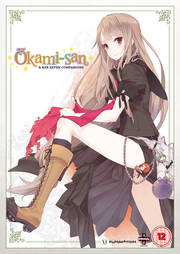





























































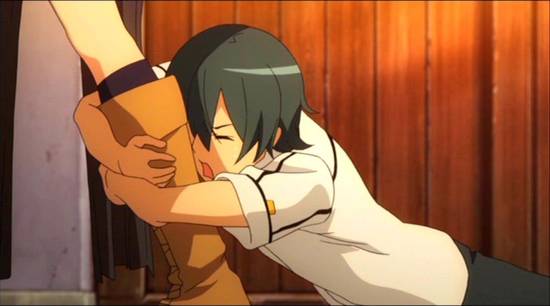
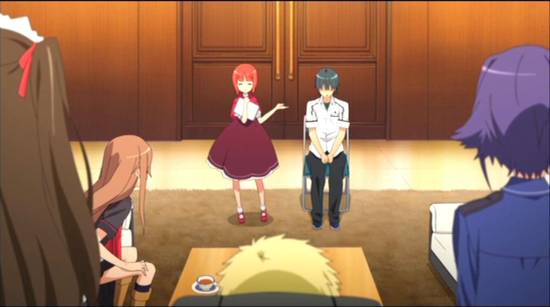







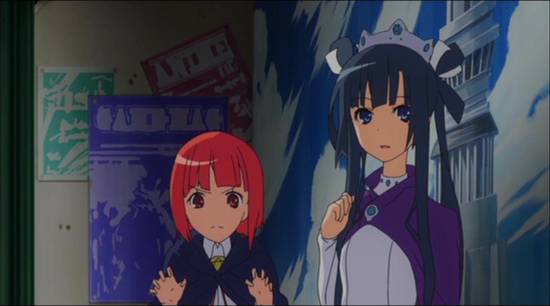
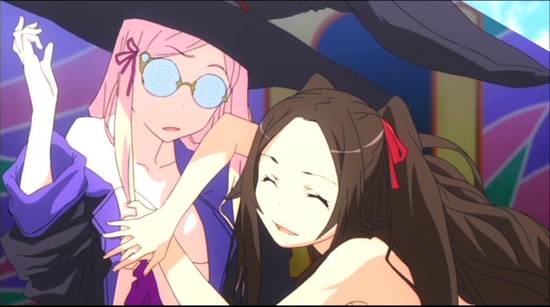


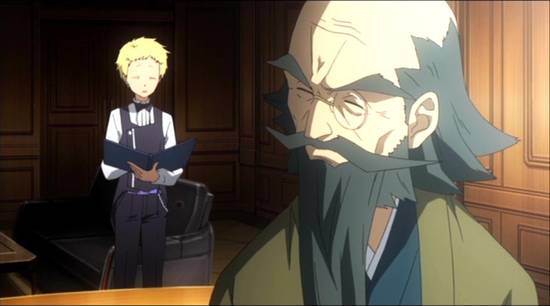



Your Opinions and Comments
Be the first to post a comment!